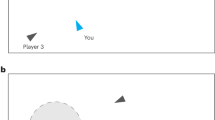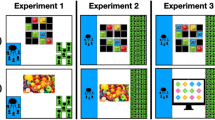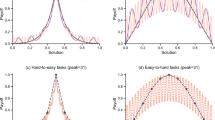Abstract
Why groups of individuals sometimes exhibit collective ‘wisdom’ and other times maladaptive ‘herding’ is an enduring conundrum. Here we show that this apparent conflict is regulated by the social learning strategies deployed. We examined the patterns of human social learning through an interactive online experiment with 699 participants, varying both task uncertainty and group size, then used hierarchical Bayesian model fitting to identify the individual learning strategies exhibited by participants. Challenging tasks elicit greater conformity among individuals, with rates of copying increasing with group size, leading to high probabilities of herding among large groups confronted with uncertainty. Conversely, the reduced social learning of small groups, and the greater probability that social information would be accurate for less-challenging tasks, generated ‘wisdom of the crowd’ effects in other circumstances. Our model-based approach provides evidence that the likelihood of collective intelligence versus herding can be predicted, resolving a long-standing puzzle in the literature.
This is a preview of subscription content, access via your institution
Access options
Access Nature and 54 other Nature Portfolio journals
Get Nature+, our best-value online-access subscription
$29.99 / 30 days
cancel any time
Subscribe to this journal
Receive 12 digital issues and online access to articles
$119.00 per year
only $9.92 per issue
Buy this article
- Purchase on Springer Link
- Instant access to full article PDF
Prices may be subject to local taxes which are calculated during checkout





Similar content being viewed by others
Code availability
The browser-based online task was built by Node.js (https://nodejs.org/en/) and socket.io (https://socket.io), and the codes are available from GitHub (https://github.com/WataruToyokawa/MultiPlayerThreeArmedBanditGame). Analyses were conducted in R (https://www.r-project.org) and simulations of individual-based models were conducted in Mathematica (https://www.wolfram.com), and the codes for both of these are available from GitHub (https://github.com/WataruToyokawa/ToyokawaWhalenLaland2018).
Data availability
Both experimental and simulation data are available in an online repository (https://github.com/WataruToyokawa/ToyokawaWhalenLaland2018).
References
Bonabeau, E, Dorigo, M. & Theraulaz, G. Swarm Intelligence: From Natural to Artificial Systems (Oxford Univ. Press, New York, 1999).
Camazine, S. et al. Self-Organization in Biological Systems (Princeton Univ. Press, Princeton, 2001).
Krause, J., Ruxton, G. D. & Krause, S. Swarm intelligence in animals and humans. Trends Ecol. Evol. 25, 28–34 (2010).
Seeley, T. D. The Wisdom of the Hive (Harvard Univ. Press, Cambridge, MA, 1995).
Sumpter, D. J. T. Collective Animal Behavior (Princeton Univ. Press, Princeton, 2010).
King, A. J. & Sueur, C. Where next? Group coordination and collective decision making by primates. Int. J. Primatol. 32, 1245–1267 (2011).
Morand-Ferron, J. & Quinn, J. L. Larger groups of passerines are more efficient problem solvers in the wild. Proc. Natl Acad. Sci. USA 108, 15898–15903 (2011).
Sasaki, T. & Biro, D. Cumulative culture can emerge from collective intelligence in animal groups. Nat. Commun. 8, 1–6 (2017).
Shaffer, Z., Sasaki, T. & Pratt, S. C. Linear recruitment leads to allocation and flexibility in collective foraging by ants. Anim. Behav. 86, 967–975 (2013).
Reid, C. R. & Latty, T. Collective behaviour and swarm intelligence in slime moulds. FEMS Microbiol. Rev. 40, 798–806 (2016).
Krause, J. & Ruxton, G. D. Living in Groups (Oxford Univ. Press, Oxford & New York, 2002).
Mackay, C. Extraordinary Popular Delusions and the Madness of Crowds (Richard Bentley, London, 1841).
Kameda, T. & Hastie, R. in Emerging Trends in the Social and Behavioral Sciences: An Interdisciplinary, Searchable, and Linkable Resource 1–14 (Wiley, Hoboken, NJ, USA, 2015).
Le Bon, G. The Crowd: A Study of the Popular Mind 4th edn (Unwin, London, 1896).
Raafat, R. M., Chater, N. & Frith, C. Herding in humans. Trends Cogn. Sci. 13, 420–428 (2009).
Bikhchandani, S., Hirshleifer, D. & Welch, I. A theory of fads, fashion, custom, and cultural change as informational cascades. J. Polit. Econ. 100, 992–1026 (1992).
Chari, V. V. & Kehoe, P. J. Financial crises as herds: overturning the critiques. J. Econ. Theory 119, 128–150 (2004).
Janis, I. L. Victims of Groupthink: A Psychological Study of Foreign Policy (Houghton Mifflin Company, Boston, 1972).
Muchnik, L., Aral, S. & Taylor, S. J. Social influence bias: a randomized experiment. Science 341, 647–651 (2013).
Salganik, M. J., Dodds, P. S. & Watts, D. J. Experimental study of inequality and unpredictability in an artificial cultural market. Science 311, 854–856 (2006).
Lorenz, J., Rauhut, H., Schweitzer, F. & Helbing, D. How social influence can undermine the wisdom of crowd effect. Proc. Natl Acad. Sci. USA 108, 9020–9025 (2011).
Jayles, B. et al. How social information can improve estimation accuracy in human groups. Proc. Natl Acad. Sci. USA 114, 201703695 (2017).
Giraldeau, L.-A., Valone, T. J. & Templeton, J. J. Potential disadvantages of using socially acquired information. Phil. Trans. R. Soc. Lond. B 357, 1559–1566 (2002).
Detrain, C. & Deneubourg, J. L. Collective decision-making and foraging patterns in ants and honeybees. Adv. Insect Physiol. 35, 123–173 (2008).
List, C., Elsholtz, C. & Seeley, T. D. Independence and interdependence in collective decision making: an agent-based model of nest-site choice by honeybee swarms. Phil. Trans. R. Soc. Lond. B 364, 755–762 (2009).
Deneubourg, J. L., Aron, S., Goss, S. & Pasteels, J. M. The self-organizing exploratory pattern of the Argentine ant. J. Insect Behav. 30, 159–168 (1990).
Beckers, R., Deneubourg, J. L. D., Goss, S. & Pasteels, J. M. Collective decision making through food recruitment. Insectes Soc. 37, 258–267 (1990).
Boyd, R. & Richerson, P. J. Culture and the Evolutionary Process (Univ. Chicago Press, Chicago, 1985).
Richerson, P. J. & Boyd, R. Not by Genes Alone (Univ. Chicago Press, Chicago, 2005).
Feldman, M. W., Aoki, K. & Kumm, J. Individual versus social learning: evolutionary analysis in a fluctuating environment. Anthropol. Sci. 104, 209–231 (1996).
Laland, K. N. Social learning strategies. Anim. Learn. Behav. 32, 4–14 (2004).
Kameda, T. & Nakanishi, D. Cost–benefit analysis of social/cultural learning in a nonstationary uncertain environment. Evol. Hum. Behav. 23, 373–393 (2002).
Kendal, R. L., Coolen, I. & Laland, K. N. The role of conformity in foraging when personal and social information conflict. Behav. Ecol. 15, 269–277 (2004).
Morgan, T. J. H., Rendell, L. E., Ehn, M., Hoppitt, W. & Laland, K. N. The evolutionary basis of human social learning. Proc. Biol. Sci. B 279, 653–662 (2012).
Toyokawa, W., Saito, Y. & Kameda, T. Individual differences in learning behaviours in humans: asocial exploration tendency does not predict reliance on social learning. Evol. Hum. Behav. 38, 325–333 (2017).
Webster, M. M. & Laland, K. N. Social learning strategies and predation risk: minnows copy only when using private information would be costly. Proc. R. Soc. B 275, 2869–2876 (2008).
Webster, M. M. & Laland, K. N. Reproductive state affects reliance on public information in sticklebacks. Proc. Biol. Sci. B 278, 619–627 (2011).
Boyd, R. & Richerson., P. J. Social learning as an adaptation. Lect. Math. Life Sci. 20, 1–26 (1989).
Bond, R. Group size and conformity. Group Process. Intergroup Relat. 8, 331–354 (2005).
Kline, M. A. & Boyd, R. Population size predicts technological complexity in Oceania. Proc. R. Soc. B 277, 2559–2564 (2010).
Muthukrishna, M., Shulman, B. W., Vasilescu, V. & Henrich, J. Sociality influences cultural complexity. Proc. R. Soc. B 281, 20132511 (2014).
Street, S. E., Navarrete, A. F., Reader, S. M. & Laland, K. N. Coevolution of cultural intelligence, extended life history, sociality, and brain size in primates. Proc. Natl Acad. Sci. USA 114, 1–7 (2017).
Nicolis, S. & Deneubourg., J. Emerging patterns and food recruitment in ants: an analytical study. J. Theor. Biol. 198, 575–592 (1999).
Pratt, S. C. & Sumpter, D. J. T. A tunable algorithm for collective decision-making. Proc. Natl Acad. Sci. USA 103, 15906–15910 (2006).
List, C. Democracy in animal groups: a political science perspective. Trends Ecol. Evol. 19, 166–168 (2004).
King, A. J. & Cowlishaw, G. When to use social information: the advantage of large group size in individual decision making. Biol. Lett. 3, 137–139 (2007).
Wolf, M. et al. Accurate decisions in an uncertain world: collective cognition increases true positives while decreasing false positives. Proc. R. Soc. B Biol. Sci. 280, 20122777 (2013).
Laan, A., Madirolas, G. & Polavieja, G. G. D. Rescuing collective wisdom when the average group opinion is wrong. Front. Robot. AI 4, 1–28 (2017).
Aplin, L. M., Sheldon, B. C. & McElreath, R. Conformity does not perpetuate suboptimal traditions in a wild population of songbirds. Proc. Natl Acad. Sci. USA 114, 7830–7837 (2017).
Barrett, B. J., Mcelreath, R. L., Perry, S. E. & Barrett, B. J. Pay-off-biased social learning underlies the diffusion of novel extractive foraging traditions in a wild primate. Proc. R. Soc. B 284, 20170358 (2017).
McElreath, R. et al. Beyond existence and aiming outside the laboratory: estimating frequency-dependent and pay-off-biased social learning strategies. Phil. Trans. R. Soc. Lond. B 363, 3515–3528 (2008).
Toyokawa, W., Kim, H.-R. & Kameda, T. Human collective intelligence under dual exploration-exploitation dilemmas. PLoS One 9, e95789 (2014).
Kandler, A. & Laland, K. N. Tradeoffs between the strength of conformity and number of conformists in variable environments. J. Theor. Biol. 332, 191–202 (2013).
Efferson, C., Lalive, R., Richerson, P. J., McElreath, R. & Lubell, M. Conformists and mavericks: the empirics of frequency-dependent cultural transmission. Evol. Hum. Behav. 29, 56–64 (2008).
McElreath, R. et al. Applying evolutionary models to the laboratory study of social learning. Evol. Hum. Behav. 26, 483–508 (2005).
Mesoudi, A. An experimental comparison of human social learning strategies: payoff-biased social learning is adaptive but underused. Evol. Hum. Behav. 32, 334–342 (2011).
Perreault, C., Moya, C. & Boyd, R. A Bayesian approach to the evolution of social learning. Evol. Hum. Behav. 33, 449–459 (2012).
Rendell, L. et al. Why copy others? Insights from the social learning strategies tournament. Science 328, 208–213 (2010).
Jolles, J. W., Laskowski, K. L., Boogert, N. J. & Manica, A. Repeatable group differences in the collective behaviour of stickleback shoals across ecological contexts. Proc. R. Soc. B 285, 13–16 (2018).
Michelena, P., Jeanson, R., Deneubourg, J.-L. & Sibbald, A. M. Personality and collective decision-making in foraging herbivores. Proc. R. Soc. B 277, 1093–1099 (2010).
Planas-Sitjà, I., Deneubourg, J.-L., Gibon, C. & Sempo, G. Group personality during collective decision-making: a multi-level approach. Proc. R. Soc. B 282, 20142515 (2015).
Mesoudi, A., Chang, L., Dall, S. R. X. & Thornton, A. The evolution of individual and cultural variation in social learning. Trends Ecol. Evol. 31, 215–225 (2016).
Barrett, B. J. Equifinality in empirical studies of cultural transmission. Behav. Process. (in the press).
Biro, D., Sasaki, T. & Portugal., S. J. Bringing a time-depth perspective to collective animal behaviour. Trends Ecol. Evol. 31, 550–562 (2016).
Hoppitt W. & Laland K. N. Social Learning: An Introduction to Mechanisms, Methods, and Models (Princeton Univ. Press, Princeton, NJ, USA, 2013).
Toelch, U., Bruce, M. J., Meeus, M. T. H. & Reader, S. M. Humans copy rapidly increasing choices in a multiarmed bandit problem. Evol. Hum. Behav. 31, 326–333 (2010).
Bahrami, B. et al. Optimally interacting minds. Science 329, 1081–1085 (2010).
Daw, N. D., O’Doherty, J. P., Dayan, P., Seymour, B. & Dolan., R. J. Cortical substrates for exploratory decisions in humans. Nature 441, 876–879 (2006).
Hergueux, J. & Jacquemet, N. Social preferences in the online laboratory: a randomized experiment. Exp. Econ. 18, 251–283 (2015).
Dandurand, F., ShultzEmail, T. R. & Onishi, K. H. Comparing online and lab methods in a problem-solving experiment. Behav. Res. Methods 40, 428–434 (2008).
Becker, J., Brackbill, D. & Centola, D. Network dynamics of social influence in the wisdom of crowds. Proc. Natl Acad. Sci. USA 114, E5070–E5076 (2017).
Lorge, I., Fox, D., Davitz, J. & Brenner, M. A survey of studies contrasting the quality of group performance and individual performance, 1920–1957. Psychol. Bull. 55, 337–372 (1958).
Hastie, R. & Kameda, T. The robust beauty of majority rules in group decisions. Psychol. Rev. 112, 494–508 (2005).
Payzan-Lenestour, E. & Bossaerts, P. Risk, unexpected uncertainty, and estimation uncertainty: Bayesian learning in unstable settings. PLoS Comput. Biol. 7, e1001048 (2011).
Sutton, R. S. & Barto, A. G. Reinforcement Learning: an Introduction (MIT Press, Cambridge, MA, 1998).
Ahn, W. Y. et al. Decision-making in stimulant and opiate addicts in protracted abstinence: evidence from computational modeling with pure users. Front. Psychol. 5, 849 (2014).
Acknowledgements
This experiment was supported by The John Templeton Foundation (40128 to K.N.L.) and Suntory Foundation research support (2015-311 to W.T.). The computer simulations and computational model analyses were supported by JSPS overseas research fellowships (H27-11 to W.T.). The phenomenological model analyses were supported by JSPS KAKENHI (grant number 17J01559). The funders had no role in study design, data collection and analysis, decision to publish or preparation of the manuscript.
Author information
Authors and Affiliations
Contributions
W.T., A.W. and K.N.L. planned the study and built the computational model. W.T. ran the simulations. W.T. and A.W. made the experimental material, ran the web-based experiment and collected the experimental data. W.T., A.W. and K.N.L. analysed the data and wrote the manuscript.
Corresponding author
Ethics declarations
Competing interests
The authors declare no competing interests.
Additional information
Publisher’s note: Springer Nature remains neutral with regard to jurisdictional claims in published maps and institutional affiliations.
Supplementary information
Supplementary Information
Supplementary Methods, Supplementary Notes, Supplementary Figures 1–10, and Supplementary Tables 1–10.
Supplementary Video 1
Brief instructions at Amazon’s Mechanical Turk, informed consent form, task instructions and tutorial.
Supplementary Video 2
Waiting room and task onset. The task starts before reaching the maximum waiting time (5 minutes). Group size is 3 in this example.
Supplementary Video 3
The final rounds of the task and participant feedback. After completing all 70 rounds, participants were presented with a questionnaire. Participants copied the unique confirmation code provided in the results screen and pasted it into Amazon’s Mechanical Turk page so as to complete the HIT.
Rights and permissions
About this article
Cite this article
Toyokawa, W., Whalen, A. & Laland, K.N. Social learning strategies regulate the wisdom and madness of interactive crowds. Nat Hum Behav 3, 183–193 (2019). https://doi.org/10.1038/s41562-018-0518-x
Received:
Accepted:
Published:
Issue Date:
DOI: https://doi.org/10.1038/s41562-018-0518-x
This article is cited by
-
Variability and harshness shape flexible strategy-use in support of the constrained flexibility framework
Scientific Reports (2024)
-
Collective incentives reduce over-exploitation of social information in unconstrained human groups
Nature Communications (2024)
-
Flexible social inference facilitates targeted social learning when rewards are not observable
Nature Human Behaviour (2023)
-
Majority rule can help solve difficult tasks even when confident members opt out to serve individual interests
Scientific Reports (2023)
-
Brain Systems Underlying Fundamental Motivations of Human Social Conformity
Neuroscience Bulletin (2023)



